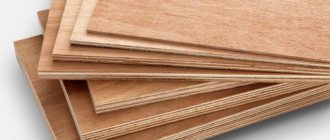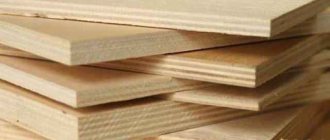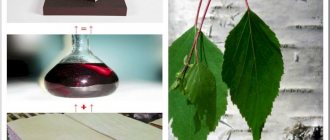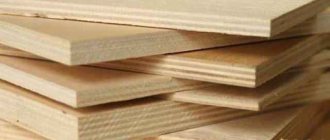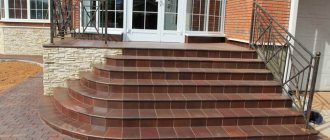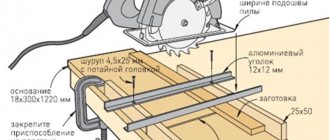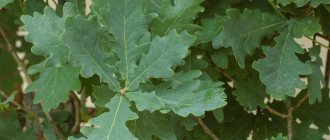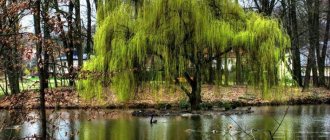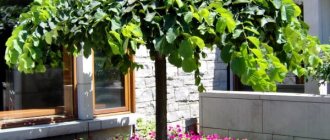The popularity of plywood products has grown even more after the development of the technology of applying laminated films. Protective coatings allow the material to be used in conditions that conventional sheets of glued veneer cannot withstand.
Waterproof laminated plywood can withstand both heavy mechanical loads and exposure to aggressive humid environments. It has found application in the production of furniture, decorative finishing of premises and transport, and the manufacture of electrical equipment.
Raw materials for plywood
The basis for lamination is plywood made using standard technologies from wood raw materials. Most often, birch and coniferous veneer are used, from which a homogeneous or combined material is made. When different raw materials are combined, the inner layers of a multilayer product are made from one wood, and the outer layers are made from raw materials of other species.
According to tradition, veneer grades are designated by the letters: A, B, C, where A is the best quality and C is the lowest quality. For outer layers, veneers A, AB, B, BB are most often used. According to the updated standard, the designations of which are not always used, the quality of the best veneer raw materials is designated by the letter E, the rest (in descending order) by numbers from 1 to 4. The marking of veneer from coniferous trees contains the letter X.
Note! Humidity indicators are of great importance for ensuring the strength of plywood products, which should be 8% with permissible deviations in both directions of 2%.
Low-grade veneer is not used for the production of laminated plywood, because the process is not economically justified. It makes no sense to put effort into laminating products intended for rough work.
Glue is applied to wood chips with rollers until the raw material is completely saturated. How much adhesive is needed depends on the density, structure and nature of the veneer.
The veneer layers, lubricated with adhesives, are first subjected to light cold pressing, then final fixation is ensured by mechanical compression under conditions of high pressure and temperatures reaching 130 ℃.
The semi-finished product for the production of laminated plywood is subjected to mandatory grinding in order to remove irregularities. The permissible thickness difference ranges from 1/8 to 1/5 of the total thickness of the resulting sheet.
Assortment
The FOB assortment is determined by the external characteristics and quality of processing of the outer layer, which is expressed in the presence of various types of defects. The state standard determines the indicators for FOB I, II and III grades.
- Grade I - visible damage to the outer layer is excluded, spots up to 25x25 mm in size are possible at the rate of 1 pc/sq.m, point distortions of the structure, film swelling, pressure from slabs and debris are unacceptable;
- Grade II - overlaps are allowed, the absence of up to 1% of the outer film coating, signs of defects in the internal layers of veneer, spots and stripes, painted over chips, a change in structure not exceeding 10% without signs of damage to the veneer;
- Grade III - possible absence of facing and overlay films, presence of stains and stripes, adhered fragments of film on top, scratches, prints from debris, chips.
Application of laminate
To obtain a laminated surface, thin protective films are placed on the plywood, which are pressed at a temperature of 136 ℃.
The time for applying the protective layer of the laminate depends on the thickness of the plywood layer and the type of polymer agent. To obtain coatings the following is used:
- melamine compounds;
- phenol-formaldehyde macromolecules;
- vinyl chloride polymers.
The process is carried out quickly. The maximum amount of time required for recording is 10 minutes. After heating, the thermosetting coating hardens completely and irreversibly.
On some types of plywood, the protective function is performed by paper oiled or impregnated with resins and secured using presses.
After receiving the laminated surface, they begin to process the ends, which must be done to ensure the durability of the plywood. They are usually coated with acrylic compounds.
Areas of application
Laminated plywood is often used in construction for formwork, floor subfloors, temporary structures, boxes and billboards. It is not afraid of mechanical influence, direct and prolonged contact with concrete, is inexpensive, and is very easy to maintain. Moisture-resistant plywood with a smooth coating is the optimal material for work inside a building, as well as for finishing work outside. It can also be used to sheathe any rooms with high humidity, bathrooms, since due to its high strength it can be laid not only on the floor. If decorative cladding is necessary, thin sheets of plywood are used that can withstand metal fasteners.
The material is suitable for creating containers. It transports equipment and components. Plywood is also relevant for lightening the weight of the structure, since with a minimum thickness it has excellent strength. At the same time, its safety and reliability remain at a high level.
There is also a cheaper option, this is FSF plywood. With the same properties of moisture resistance and strength of the sheet, there will be no film on it, which accordingly reduces the cost of the final product, thus often saving on the production of vans, trailers and even cars. You can often see the corresponding sheets in the designs of public benches and benches.
You can buy laminated plywood from our company. You can place an order by calling the phone number listed in the contacts, or by leaving a request on the website. Our managers will contact you as soon as possible, give detailed advice on products and help you place your order. At the same time, we are ready to offer cutting sheets to your sizes and delivery of the material.
Varieties and main varieties
According to the state standard approved in 2010, laminated plywood is designated by the abbreviation FOB and is made from birch veneer. Laminated plywood products from other types of veneer raw materials are produced according to the technical specifications of manufacturing enterprises. In relation to them, the marking FOF is sometimes found.
Depending on the resulting surface texture on one or both sides, products are marked with the following letter combinations:
- F/F – smooth film surface on each of two sides;
- F/W – film on one side and mesh on the other side;
- SP/SP – smooth double-sided film coating, prepared for subsequent painting;
- F/SP is a film that is not painted on one side of the plywood, but pigments are applied on the other;
- F/U – one side is smooth, the other is untreated.
According to GOST, finished laminated products are divided into grades: from 1st to 3rd. Products of the first grade cannot have areas not protected by polymers; the permissible overlap of the laminate should not exceed 5 mm.
Adhesion of pieces of remaining polymer may occur in areas of up to 5 cm2. There should be no scratches or damage on products of this class.
Laminated products of the 2nd grade can have up to 3 blisters, 2 scratches, spots, the size of which does not exceed 10% of the area.
The number of defects on grade 3 laminated plywood is not strictly limited; It has the most affordable price; when used, it requires additional effort to mask flaws.
General information
The basic process of making laminated plywood does not have any special features - the logs are cut into veneer, which is subsequently treated with glue, placed in bags and pressed. However, after receiving the finished sheets, they are additionally laminated, i.e. covered with film.
The film is a thick paper impregnated with mixed melamine-formaldehyde or phenolic resins.
This coating has the following properties:
- good strength;
- water resistance;
- wear resistance;
- antiseptic effect;
- density.
Options for the appearance of laminated plywood
It should be noted that during the lamination process, the ends of the boards are treated with acrylic waterproof paint, which also makes the material less vulnerable to moisture.
In addition, we can highlight other positive properties of laminated plywood acquired as a result of such processing:
- crack resistance and high strength;
- resistance to temperature fluctuations;
- immunity to aggressive chemicals, including fuels and lubricants;
- resistance to decay and other biological influences.
As for the disadvantages, they include a higher price. In addition, the material becomes less environmentally friendly.
Note! If the sheet is cut, the cut area must be treated with a protective compound yourself, otherwise the water resistance of the material will decrease.
Example of exterior use of laminated plywood
Formwork and transport products
All types of plywood for which resins were used are highly resistant to moisture: bakelite, formaldehyde or melamine. Only products made from veneer glued with protein agents are not suitable for use in a humid environment.
Laminated plywood for formwork based on FSF sheets has an increased degree of protection, has a polymer coating on the outside that repels water, and is characterized by high turnover. This means that the formwork material can be used up to 50 times, and with careful care and careful use - up to 100 times. With such a turnover, the cost of purchasing high-quality laminated plywood will pay for itself many times over.
To increase the resistance of the outer surface to abrasion and reduce slipping, polymer meshes with different cell sizes are fixed on the sheets. Such mesh plywood is also called transport plywood, since it is used for lining the bottom of vans and ships.
Laminated transport plywood has a corrugated surface, helps keep cargo in its original installation location, and simplifies the loading and unloading procedure. It can also be used for formwork, trailer cladding, garden furniture, and playgrounds.
Production
Sanded waterproof birch plywood of emission class E1 is used as a raw material for laminated boards. And a film based on thermoset, obtained by impregnating paper with a thermosetting resin that hardens when heated.
All defects in the outer layers must be repaired. These include:
- not completely fused knots;
- unfused knots;
- falling out knots;
- cracked knots;
- knot holes;
- wormholes;
- loose cracks.
To eliminate defects, veneer inserts or putty are used. The end part of the sheet is treated with an acrylic-based water emulsion.
Colored coatings
Pigments can be added to the synthetic layer to give a particular color to the material.
White laminated plywood can be used to decorate the bathroom and other wet rooms in the apartment. At the request of customers, many enterprises are ready to make products in different colors. Modern technologies make it possible to quickly apply dyes to laminated wood products.
Bright colored sheets are used for the construction of children's playgrounds.
Darker or lighter laminated plywood is used for the production of vans, seats in public places, and partitions in transport.
Conclusion
Laminated plywood has high technical characteristics, especially regarding its strength and moisture resistance. Therefore, it is often an indispensable material for outdoor work. However, when choosing, you should take into account that there are quite a few types of it on the market, differing in some important properties.
The video in this article contains additional information on the topic discussed. If you have any questions while reading the material, you can leave them in the comments, and we will be happy to answer them.
Appendix D (mandatory)
Method for determining resistance to cement
A cement mortar is prepared from the ratio: 120 g of cement and 50 g of water.
Five 30-40 g pours of cement mortar are placed on a 30x30 cm plywood sample.
After 24 hours, the fillers are removed from the surface of the plywood in a cured state and dried for 6 days.
On the seventh day, the change in color of the hardened cement mortar is assessed on a three-point scale:
1 - No staining.
2 - Partial coloring of the edges.
3 - All edges are painted.
A fully cured plywood surface will not change the color of the cement. A reddish tint indicates that the phenolic film is not completely cured.
Appendix B (mandatory)
Method for determining resistance to sodium hydroxide (NaOH)
A 5% NaOH solution is poured into a glass cup with a capacity of approximately 50 ml. The plywood sample is pressed tightly on top so that approximately 10 cm remains from the edge of the cup to the edge of the sample. Then the plywood sample along with the cup is turned 180° so that the solution wets the surface of the plywood and left for 2 hours.
The resistance of plywood to sodium hydroxide is assessed by the change in color of the solution:
Saturated yellow color - the film is under-cured.
Light yellow—film curing is normal.
Colorless - complete curing of the film.
7 Control methods
7.1 Sampling - according to GOST 9620, GOST 27678 and [4].
7.2 The length and width of plywood are measured at two points parallel to the edges at a distance of at least 100 mm from the edges with an error of 1 mm using a metal tape in accordance with GOST 7502. The arithmetic mean of the results of two measurements is taken as the actual length (width) of the sheet.
7.3 Thickness is measured at a distance of at least 25 mm from the edges and in the middle of each side of the sheet with an error of up to 0.1 mm with a thickness gauge according to GOST 11358 or a micrometer according to GOST 6507.
The arithmetic mean of the results of four measurements is taken as the actual sheet thickness.
The thickness difference in one sheet of plywood is defined as the difference between the largest and smallest thickness of four dimensions.
7.4 Humidity - according to GOST 9621.
7.5 Tensile strength when chipping along the adhesive layer - according to GOST 9624.
7.6 Ultimate strength and modulus of elasticity during static bending - according to GOST 9625.
7.7 Tensile strength - according to GOST 9622.
7.8 Formaldehyde content - according to GOST 27678, this method is used as an arbitration method, release of formaldehyde into the environment - according to GOST 30255 and [4], [5].
7.9 Measurement of processing defects - according to GOST 30427.
7.10 Deviation from straightness of the edges of a plywood sheet is determined with an error of 0.2 mm by measuring the maximum gap between the edge of the sheet and the edge with a metal ruler in accordance with GOST 427 and a feeler gauge in accordance with GOST 8925.
7.11 Measuring slant and warp - according to GOST 30427.
7.12 Steam resistance - in accordance with Appendix B.
7.13 Resistance to sodium hydroxide (NaOH) - in accordance with Appendix B.
7.14 Resistance to cement - in accordance with Appendix D.
Appendix B (mandatory)
Method for determining steam resistance
Fill a flask with a capacity of 500 ml with a neck diameter of 60 mm until it is half filled and boil.
A sample of plywood is placed tightly on the neck and kept over steam for 60 minutes.
After exposure, the sample is removed, dried and the degree of damage is assessed on a three-point scale:
1 - No swelling. Slight loss of gloss. There are no bubbles.
2 - Slight swelling over the entire surface. Change in gloss. Slight bubble formation.
3 - Severe swelling. Significant change in gloss. Severe blistering.
